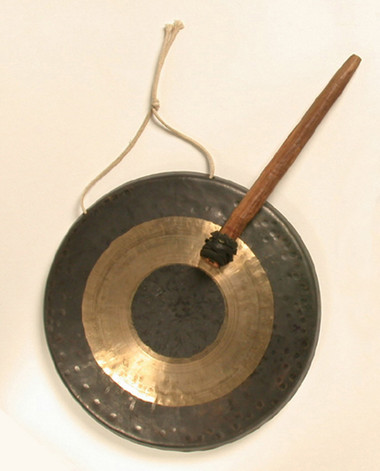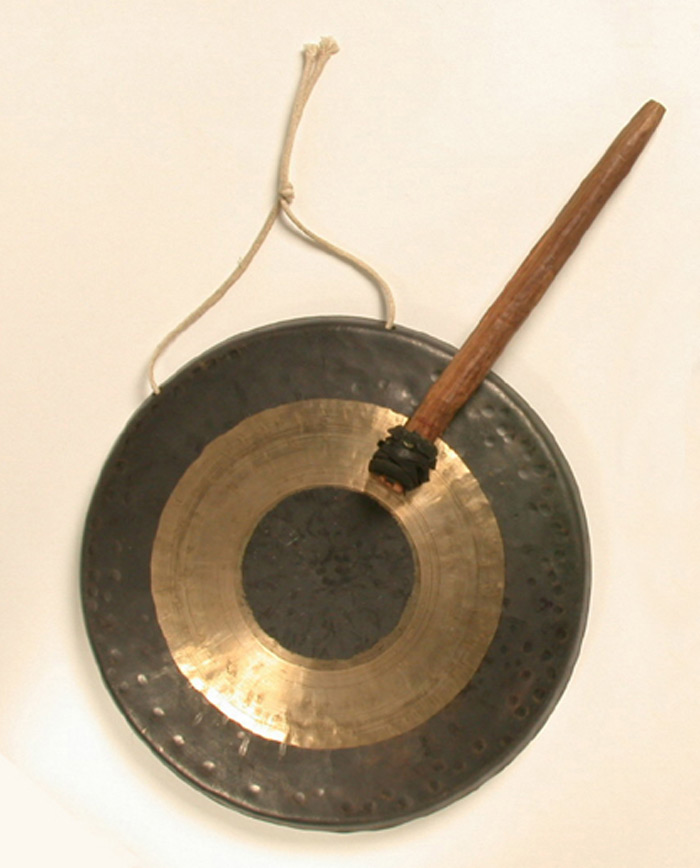Brass Gong, China
This brass Chinese Gong is known as a Chao Gong. It is a disc with a flat face and turned-back rim, similar in shape to Chinese straw hats. String is looped through two holes at the top of the gong to make a handle. The gong has a black circle painted in the centre and a wide black-painted rim around the edge. Between the two black areas is an unpainted ring of brass. This is the area that is struck.
The gong is suspended from a frame or held in one hand by the string handle so that it hangs vertically. The player strikes the gong with a heavy mallet covered in wool or felt. By varying the power of the strike and by hitting the gong in different places, the player can vary the quality of the sound made. Striking the gong squarely in the centre gives a loud sound, while striking it near the rim makes a quieter one. The vibration is strongest nearest the centre and weakest nearest the rim.
The gong is suspended from a frame or held in one hand by the string handle so that it hangs vertically. The player strikes the gong with a heavy mallet covered in wool or felt. By varying the power of the strike and by hitting the gong in different places, the player can vary the quality of the sound made. Striking the gong squarely in the centre gives a loud sound, while striking it near the rim makes a quieter one. The vibration is strongest nearest the centre and weakest nearest the rim.

Gong Diameter:30cm
Gongs
According to Chinese tradition, gongs came from the western region between Tibet and Burma. They are mentioned as early as the 6th century, in the time of Emperor Hsuan Wu.
The Chao gong is a percussion instrument of indefinite pitch. This means that it can only sound the same kind of note and not a scale or higher and lower notes. It is similar to the Chinese tam-tam, a large flat gong 70cm or more in diameter, with a shallow lip and, again, indefinite pitch. A genuine Chinese tam-tam was used to record the strokes heard on the J. Arthur Rank film trademark.
This gong is made from brass. It is cast, then hammered, smoothed and tuned. Finally it is polished and decorated.
Gongs are used in several ways in Southeast Asia. In processions the gong drives away evil spirits; it announces departure aboard a ship; it is the signal for the outbreak of fire; in songs it marks the tune. A small gong may announce a sweet peddler and his cart of sweets. A large gong may trumpet the approach of an official with his retinue. In Buddhist temples the gong is beaten to call the attention of the spirits.
According to Chinese tradition, gongs came from the western region between Tibet and Burma. They are mentioned as early as the 6th century, in the time of Emperor Hsuan Wu.
The Chao gong is a percussion instrument of indefinite pitch. This means that it can only sound the same kind of note and not a scale or higher and lower notes. It is similar to the Chinese tam-tam, a large flat gong 70cm or more in diameter, with a shallow lip and, again, indefinite pitch. A genuine Chinese tam-tam was used to record the strokes heard on the J. Arthur Rank film trademark.
This gong is made from brass. It is cast, then hammered, smoothed and tuned. Finally it is polished and decorated.
Gongs are used in several ways in Southeast Asia. In processions the gong drives away evil spirits; it announces departure aboard a ship; it is the signal for the outbreak of fire; in songs it marks the tune. A small gong may announce a sweet peddler and his cart of sweets. A large gong may trumpet the approach of an official with his retinue. In Buddhist temples the gong is beaten to call the attention of the spirits.

Gong Diameter:30cm

This brass Chinese Gong is known as a Chao Gong. It is a disc with a flat face and turned-back rim, similar in shape to Chinese straw hats. String is looped through two holes at the top of the gong to make a handle. The gong has a black circle painted in the centre and a wide black-painted rim around the edge. Between the two black areas is an unpainted ring of brass. This is the area that is struck.
The gong is suspended from a frame or held in one hand by the string handle so that it hangs vertically. The player strikes the gong with a heavy mallet covered in wool or felt. By varying the power of the strike and by hitting the gong in different places, the player can vary the quality of the sound made. Striking the gong squarely in the centre gives a loud sound, while striking it near the rim makes a quieter one. The vibration is strongest nearest the centre and weakest nearest the rim.
The gong is suspended from a frame or held in one hand by the string handle so that it hangs vertically. The player strikes the gong with a heavy mallet covered in wool or felt. By varying the power of the strike and by hitting the gong in different places, the player can vary the quality of the sound made. Striking the gong squarely in the centre gives a loud sound, while striking it near the rim makes a quieter one. The vibration is strongest nearest the centre and weakest nearest the rim.
- Term:
- Description:
- Brass
- An alloy of zinc and copper.
- Indefinite pitch
- When an instrument can only be used to make one sound. It cannot be used to play a scale or higher and lower notes and it cannot be tuned. The term usually refers to percussion instruments.
- Mallet
- A wooden object like a hammer.




















